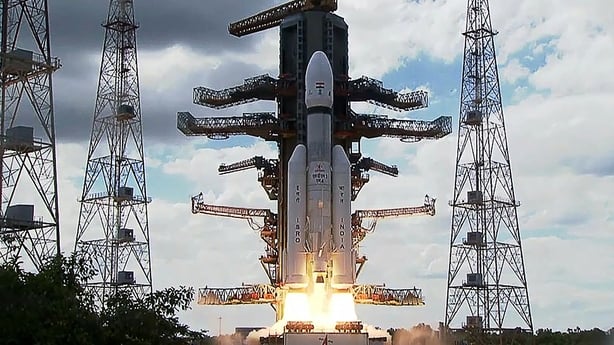India's space agency has launched a rocket that sent a spacecraft into orbit and toward a planned landing next month on the lunar south pole, an unprecedented feat that would advance India's position as a major space power.
The Indian Space Research Organisation's (ISRO) LVM3 launch rocket blasted off from the country's main spaceport in the southern state of Andhra Pradesh, leaving behind a plume of smoke and fire.
About 16 minutes later, ISRO's mission control announced that the rocket had succeeded in putting the Chandrayaan-3 lander into an Earth orbit that will send it looping toward a moon landing next month.
If the mission succeeds, India would join a group of three other countries that have managed a controlled lunar landing, including the United States, the former Soviet Union and China.
The Chandrayaan-3 spacecraft would also be the first to land at the lunar south pole, an area of special interest for space agencies and private space companies because of the presence of water ice that could support a future space station.
The rocket blasted off from India's main spaceport at 2.35pm local time.

Over 1.4 million people watched the launch on ISRO's YouTube channel, many offering congratulations and the patriotic slogan "Jai Hind" (Victory to India).
In 2020, ISRO's Chandrayaan-2 mission successfully deployed an orbiter but its lander and rover were destroyed in a crash near where the Chandrayan-3 will attempt a touchdown.
Chandrayaan, which means "moon vehicle" in Sanskrit, includes a 2-metre-tall lander designed to deploy a rover near the moon's south pole, where it is expected to remain functional for two weeks running a series of experiments.
The lunar landing is expected on 23 August, ISRO has said.
The launch is India's first major mission since Prime Minister Narendra Modi's government announced policies to spur investment in space launches and related satellite-based businesses.
Mr Modi had earlier said on Twitter that the moon mission "will carry the hopes and dreams of our nation".
"As Mother India enters into the next 25 years, she pledges to play a leading global role in the emerging world scenario," Deputy Minister of State for Science and Technology Jitendra Singh said in an event at the spaceport to celebrate the launch.
The mission comes with a price tag of $74.6 million - far smaller than those of other countries', and a testament to India's frugal space engineering.
Experts say India can keep costs low by copying and adapting existing space technology, and thanks to an abundance of highly skilled engineers who earn a fraction of their foreign counterparts' wages.
Since 2020, when India opened to private launches, the number of space startups has more than doubled.
Late last year, Skyroot Aerospace, whose investors include Singapore's sovereign wealth fund GIC, launched India's first privately built rocket.
In 2014, India became the first Asian nation to put a satellite into orbit around Mars, and three years later, the ISRO launched 104 satellites in a single mission.
The ISRO's Gaganyaan ("Skycraft") programme is slated to launch a three-day manned mission into Earth's orbit by next year.
Read more: NASA finds missing Indian moon lander - with some help

